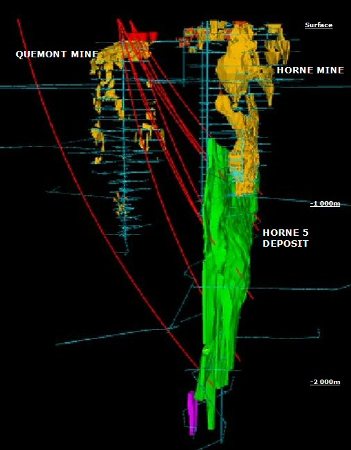Feb 11 2015
Falco Resource Ltd. announced that it has commenced an inaugural drill program on the Horne 5 Au-Ag-Cu-Zn deposit in Rouyn-Noranda, Quebec.
 Figure 1. Confirmation and Metallurgical Drilling of Horne 5 - Image of the Horne Mine, Quemont Mine and Horne 5 Deposit showing the 16,000 metre drill campaign (in red), looking Northeast.
Figure 1. Confirmation and Metallurgical Drilling of Horne 5 - Image of the Horne Mine, Quemont Mine and Horne 5 Deposit showing the 16,000 metre drill campaign (in red), looking Northeast.
This program is intended to confirm historical drill data, upgrade the size and confidence level of the mineral resource estimate and provide material for metallurgical testing (Figure 1).
Highlights / Objectives
- 16,000 metre surface drill program consisting of 9-holes and 9 wedge holes
- $3.7M budget
- Metallurgical testing to establish recoveries for Au, Ag, Cu and Zn
- Drilling to be completed by September 2015, initial metallurgical results anticipated in June 2015
- Silver content expected to be added to new 43-101 resource estimate
- Upgrade current resource estimate from inferred to indicated classification
- Geotechnical studies to assist future mine design
- Preliminary engineering studies to include hydrogeology, hoisting, rock mechanics and environmental
- Updated NI 43-101 resource estimate anticipated in Q4 2015
Horne Project
The Horne Project area encompasses the former producing Horne and Quemont mines as well as the Horne 5 deposit. The Horne mine was operated by Noranda from 1927 to 1976 and produced 11.6 million ounces of gold and 2.5 billion pounds of copper. The Quemont mine is located 600 metres north of Horne and produced approximately 2 million ounces of gold and 400 million pounds of copper between 1949 and 1971.
The Horne 5 deposit lies immediately below the historical Horne mine. Together, Horne and Horne 5 share many similarities to Agnico-Eagle's La Ronde mine located 40 kilometres to the east. The two orebodies are dynamic multi-metallic systems that remain open, plunging steeply to depth for several kilometres.
Falco released a maiden 43-101 mineral resource estimate for the Horne 5 deposit in March 2014 delineating an inferred resource of 25.3 million tonnes grading 2.64 g/t Au, 0.23% Cu and 0.7% Zn. The Company recently secured surface rights above the Quemont mine in order to safeguard property rights for future use.
Program Parameters
The program will consist of 9 holes and 9 wedge holes targeting five mineralized zones within the Horne 5 deposit. The holes will vary between 1,000 and 2,250 metres in length, with the deepest drill hole targeting a high-grade gold zone at depth.
16 of the 18 holes will be collared above the former producing Quemont mine. All holes will be drilled to the south passing through the Quemont mine area, the boundary zone between the two mine sites and then into the Horne 5 deposit. Attention will be paid to intersections of anomalous and potentially new mineralized areas marginal to the two deposits. Assay results will be released periodically as available.
Deliverables and Timeline
The Company has retained G4 Drilling for the first phase of drilling. Drilling will run continuously until September 2015.
Materials will be collected from the 9 wedge holes spanning the full extent of the known deposit for metallurgical testing. Initial test results are anticipated by June. Metallurgical testing is required to optimize metal recoveries and geotechnical information is required for future mine design. All studies will be completed in tandem with the drill program, laying the groundwork to support a future preliminary economic assessment on the Horne 5 project.
Upon completion of the drill program and receipt of all metallurgical studies, the Company will commission a new NI 43-101 technical report, which it expects to release in Q4 2015.
"We are bringing a contemporary perspective to a historic mine 38 years after Horne ceased operating," said Trent Mell, President and CEO. "This is a very significant work program for Falco, as the deliverables over the next eight months are expected to confirm the tremendous potential of the Horne Project."
Community Relations
Falco is committed to building relationships within Rouyn-Noranda and other communities in which it operates and sustainability is an integral part of its business plans and decision-making processes. Falco will not compromise on this core value and will partner with local communities for long-term mutual benefit.